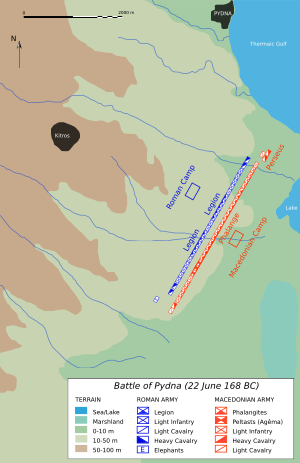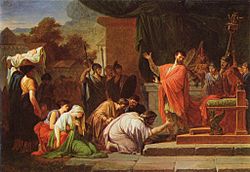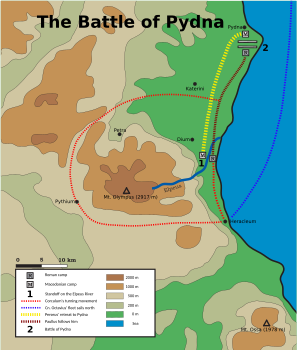Battle of Pydna facts for kids
Quick facts for kids Battle of Pydna |
|||||||
|---|---|---|---|---|---|---|---|
| Part of the Third Macedonian War | |||||||
 Dispositions prior to the battle |
|||||||
|
|||||||
| Belligerents | |||||||
| Commanders and leaders | |||||||
| Lucius Aemilius Paullus P. Cornelius Scipio Nasica |
Perseus (POW) | ||||||
| Strength | |||||||
| 38,600 men ● 2,600 cavalry 22 war elephants |
43,000 men ● 4,000 cavalry |
||||||
| Casualties and losses | |||||||
| Unknown | 31,000 •20,000 killed •11,000 captured |
||||||
The Battle of Pydna was a huge fight in 168 BC. It happened between Rome and Macedon. This battle was a key part of the Third Macedonian War. Rome's victory showed its growing power in the ancient world. It also marked the end of the Antigonid family's rule in Macedon. Their kings had been in power since the time of Alexander the Great. Many historians see this battle as a win for the flexible Roman legion system over the rigid Macedonian phalanx.
Contents
Road to Pydna: The Third Macedonian War Begins
The Third Macedonian War started in 171 BC. King Perseus of Macedon made some moves that angered Rome. This led Rome to declare war. At first, Rome won some small battles. This was partly because Perseus did not keep his armies together.
Later that year, things changed. Perseus won a battle at Battle of Callinicus. He got back most of the land he had lost. This included the important city of Dion. Perseus then set up his army in a very strong spot. It was by the Elpeus river in northeastern Greece. This position was almost impossible to attack directly.
Roman Strategy: Tricking the Enemy
The next year, Lucius Aemilius Paullus took command of the Roman army. He was a very experienced soldier. He was also one of Rome's two top leaders, called a consul. Paullus wanted to force Perseus out of his strong river position.
Paullus sent a small group of soldiers to the coast. This group was led by Publius Cornelius Scipio Nasica Corculum. It was a trick to make Perseus think the Romans would attack from the sea. But that night, Scipio secretly moved his troops south. They went over the mountains west of the main armies. They marched to Pythion, then turned northeast. Their plan was to attack the Macedonians from behind.
Macedonian Response and New Positions
A Roman soldier who had left his army told the Macedonians about the plan. King Perseus quickly sent 12,000 soldiers to stop Scipio. These Macedonian troops were led by Milo. The fight that followed pushed Milo's men back. They returned in disarray to the main Macedonian army.
After this, Perseus moved his army north. He set up near Katerini, a village south of Pydna. This area was a flat plain. It was perfect for his phalanx formation.
Paullus then had Scipio rejoin the main Roman army. Perseus had prepared his forces for an attack from the south. But the Roman armies were actually to the west. When they advanced, they found Perseus's army ready. The Roman soldiers were tired from their march. So, Paullus decided not to fight right away. They set up camp in the foothills of Mount Olocrus to the west.
Omens and the Start of Battle
The night before the battle, there was a lunar eclipse. The Macedonians saw this as a bad sign. They thought it meant their king would fall. Paullus, however, knew that eclipses happened regularly. Still, he performed sacrifices and waited for good signs.
The fighting began the next afternoon, on June 22. Historians have different ideas about how the battle started. One story says Paullus waited until the sun would not be in his soldiers' eyes. Then he sent a loose horse forward to cause confusion. Another idea is that some Roman soldiers looking for food got too close. They were then attacked by Thracian soldiers in Perseus's army.
The Battle of Pydna: Clash of Giants
The Roman army had at least 28,600 men, possibly up to 37,000. This included Roman, Italian, and Greek foot soldiers. They also had allies from Numidia and Liguria. The Macedonian army started the war with 43,000 soldiers. More than 20,000 of these were phalangites. Both sides had about 4,000 cavalry (soldiers on horseback). By the time of the battle, the Macedonian army was closer to 30,000 men.
Army Formations and Initial Attacks
Both armies lined up in their usual ways. The Romans put their two main legions in the middle. Their allied foot soldiers were on the sides. The cavalry was on the far ends, or "wings." The Roman right side also had 22 war elephants.
The Macedonian phalanx was in the center of their line. Their best 3,000 soldiers, called the Guard, were to the left of the phalanx. Lighter soldiers, called peltasts, and Thracians guarded the sides of the phalanx. The Macedonian cavalry was also on both sides. Perseus himself commanded the heavy cavalry on the Macedonian right. This included his best "Sacred Squadron" and Thracian cavalry. However, some reports say the cavalry did not fight.
The main parts of the armies met around 3 PM. The Macedonians moved forward toward the Roman camp. Paullus later said the sight of the phalanx filled him with fear. The Roman allies tried to break the enemy's long pikes. They also tried to cut off their points. But they had little success. Roman officers began to lose hope. One officer even tore his clothes in frustration. Another threw his unit's flag into the enemy. His men charged to get it back, but they were pushed back. They could not get past the thick wall of pikes. The Romans then used a planned retreat over the rough ground.
Roman Breakthrough and Macedonian Defeat
As the phalanx pushed forward, the ground became more uneven. This caused the phalanx's tight line to break apart. Gaps appeared in their formation. Paullus quickly ordered his legions into these gaps. They attacked the Macedonian phalangites on their exposed sides. In close combat, the longer Roman sword and heavier shield were much better. They easily beat the Macedonian Kopis (a type of sword) and lighter shields. The Roman right side also joined the fight. They had already defeated the Macedonian left.
Seeing the battle turn, King Perseus fled with his cavalry. According to Plutarch, Perseus's cavalry had not even fought yet. Both the king and his cavalry were called cowards by the Macedonian foot soldiers who survived. Another report says Perseus was hurt early in the battle.
The 3,000 strong Macedonian Guard fought until they died. Nearly 11,000 Macedonians were captured. Some reports say up to 20,000 Macedonians were killed. The main battle lasted about an hour. But the chase after the fleeing Macedonians lasted until nightfall. Other reports say that about 10,000 Macedonian soldiers did not fight at all. This was due to confusion or a mistake by the king.
Heroes and Lessons Learned
There were several Roman heroes in the battle. Paullus's son, Scipio Aemilianus, was thought to be lost for a while. But he and his friends had been chasing the fleeing Macedonians. The son of Cato the Elder, Marcus Porcius Cato Licinianus, also showed great bravery. He lost his sword in a fight but managed to get it back.
This battle is often seen as a win for the Roman legion's flexibility. It showed how it could beat the phalanx's rigid style. However, many modern experts believe the loss was due to King Perseus's poor leadership. They also point to the Companion cavalry not joining the fight. The 3,000 Agema peltasts fought well and kept their formation longer. This suggests that good training was very important for both the strength of the phalanx and for breaking through it.
Aftermath: The End of Macedonian Power

The Battle of Pydna was not the very last fight between Rome and Macedon. But it completely broke Macedon's power. This battle and its results marked the end of Macedon's independence. It would become a Roman province a few years later.
The political results of losing the battle were very serious. King Perseus later gave himself up to Paullus. He was then paraded through Rome in chains during a victory parade. After that, he was put in prison. The Roman Senate decided to send many of the king's friends to Italy. Perseus himself was kept under house arrest.
The Macedonian kingdom was broken up. It was replaced by four separate republics. These republics were not allowed to trade or interact much with each other. Over time, these republics were also dissolved. Macedon then became a full Roman province. In 167 BC, Paullus was ordered to attack Epirus. This led to 150,000 people from Epirus being enslaved. Seventy cities were also destroyed. This happened because one tribe from Epirus had helped Perseus. But all the people of Epirus suffered from the Roman attack.
The victory was celebrated in Athens. A special order was passed in 168 BC. It honored Calliphanes, an Athenian citizen. He had been with the Roman army at Pydna. He brought the news of the victory to Athens.
See also
 In Spanish: Batalla de Pidna para niños
In Spanish: Batalla de Pidna para niños
- Monument of Aemilius Paullus, a monument that celebrates the Roman victory in the Battle of Pydna


